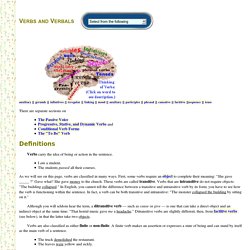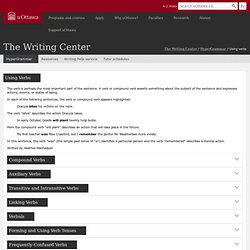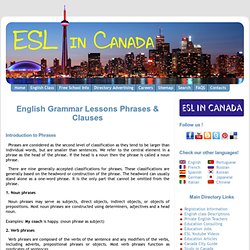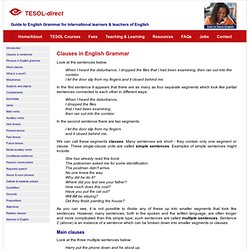

Verbs and Verbals. Auxiliary || gerunds || infinitives || irregular || linking || mood || auxiliary || participles || phrasal || causative || factitive ||sequence || tense There are separate sections on Definitions Verbs carry the idea of being or action in the sentence.

I am a student. The students passed all their courses. As we will see on this page, verbs are classified in many ways. Although you will seldom hear the term, a ditransitive verb — such as cause or give — is one that can take a direct object and an indirect object at the same time: "That horrid music gave me a headache. " Verbs are also classified as either finite or non-finite. The truck demolished the restaurant.The leaves were yellow and sickly. Non-finite verbs (think "unfinished") cannot, by themselves, be main verbs: The Linking Verb. Linking verbs do not express action.

Instead, they connect the subject of the verb to additional information about the subject. Look at the examples below: Keila is a shopaholic. Ising isn't something that Keila can do. Is connects the subject, Keila, to additional information about her, that she will soon have a huge credit card bill to pay. Linking Verbs. A verb indicates the time of an action, event or condition by changing its form.

Through the use of a sequence of tenses in a sentence or in a paragraph, it is possible to indicate the complex temporal relationship of actions, events, and conditions There are many ways of categorising the twelve possible verb tenses. The verb tenses may be categorised according to the time frame: past tenses, present tenses, and future tenses. Verb Tense: Time. Linking_verbs.pdf (application/pdf Objeto) Introduction to English Phrases and Clauses. Introduction to Phrases Phrases are considered as the second level of classification as they tend to be larger than individual words, but are smaller than sentences.

We refer to the central element in a phrase as the head of the phrase. If the head is a noun then the phrase is called a noun phrase. There are nine generally accepted classifications for phrases. These classifications are generally based on the headword or construction of the phrase. 1. Noun phrases may serve as subjects, direct objects, indirect objects, or objects of prepositions. Examples: My coach is happy. The Prepositional Phrase. Printer Fabulous!

Recognize a prepositional phrase when you see one. At the minimum, a prepositional phrase will begin with a preposition and end with a noun, pronoun, gerund, or clause, the "object" of the preposition. Phrases, Clauses, and Sentences: Middle School Grammar Essentials. English grammar - clauses in sentences. - Waylink English. Look at the sentences below.

When I heard the disturbance, I dropped the files that I had been examining, then ran out into the corridor. I let the door slip from my fingers and it closed behind me. In the first sentence it appears that there are as many as four separate segments which look like partial sentences connected to each other in different ways: When I heard the disturbance, I dropped the files that I had been examining, then ran out into the corridor. In the second sentence there are two segments: I let the door slip from my fingers and it closed behind me. We can call these segments clauses. She has already read this book. As you can see, it is not possible to divide any of these up into smaller segments that look like sentences.
Main clauses Look at the three multiple sentences below: Harry put the phone down and he stood up. The sentences can be divided into clauses as follows, and the main clauses are in bold. Harry put the phone down (and) he stood up. The Structure of a Sentence. Schoolhouse Rock Verbs. Verb Rap Song. Parts of Speech Rap Song. Grammar: Brief and Naughty - Part 1: The Eight Parts of Speech. The Subjunctive Mood. The Subjunctive Mood Most Indo-European languages, in addition to verb tenses (which demonstrate time), have verb moods (which indicate a state of being or reality).

For instance, the most common moods in English include the indicative, the imperative, the interrogative, and the conditional. Another, rarer mood is the subjunctive mood (indicating a hypothetical state or a state contrary to reality, such as a wish, a desire, or an imaginary situation). It is harder to explain the subjunctive. Five hundred years ago, English had a highly developed subjunctive mood. 1. Subjunctive: "If I were a butterfly, I would have wings. " Note that in the indicative, we normally write, "I was. " Indicative: "When I was a butterfly in a former life, I had wings. " In this sentence, the author uses the indicative to indicate that she indeed was a butterfly in the past, and she is not just hypothetically speaking about a situation contrary to her reality. 2. Subjunctive: "You sneezed! Parts of Speech Lesson Plan: Vary Sentence Beginnings by Utilizing the Parts of Speech.